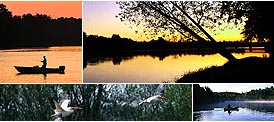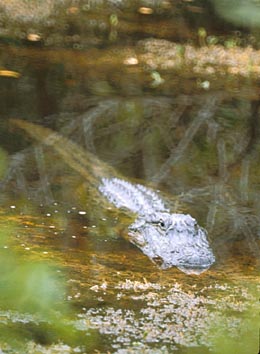

| | 
Fishing the Dropper Fly
by Cameron Larsen
Over the past decade or so, some fly fishers have hailed the dropper system as the latest and greatest thing to hit fly fishing since the graphite fly rod. The truth is the two fly dropper system has been around since fly fishing began. Like all techniques it has gone in and out of style over the generations. As new technologies are developed, fly fishing trends change, some things are labeled obsolete only to experience a re-birth later on. For whatever reason the dropper fly has experienced just such a re-birth and its uses are becoming more varied as well.
The two fly dropper system is simply a way to fish two flies at one time, actually a fly fisher could fish more than two flies, but for this article we will stick to just two flies. The advantages of fishing two flies can be many. You can more quickly identify the 'hot fly', if fish hit one fly repeatedly you can eliminate the dropper fly. Another advantage is your ability to search through multiple levels in the water column. The theory goes that finding the depth where fish are holding will increase your chances of getting hits. Depending on the food sources immediately available, fish can be holding down at the bottom, or swirling near the surface, a dropper allows you to explore these possibilities.
Dropper Techniques
There are two basic dropper combinations. One is the sinker/sinker combo, and the other is the dry fly/dropper, sometimes called the hopper/dropper as hopper patterns work very well for this. In the sinker/sinker combo, two sub-surface patterns, are used, usually combined with split shot weights.
There are two trains of thought in the sinker/sinker combo. One is you attach the smaller fly first in the sequence and then attach the larger fly, such as a stonefly nymph and attach a split shot in between the flies. The idea here is that the smaller fly, perhaps an emerger pattern, will stay in the upper portion of the water column while the stonefly will sink down, towards the bottom, where the fish is most apt to strike them.
Others (including yours truly) take the opposite approach. Attach the bigger fly first, take that Stonefly nymph for example, put the weight above it, and then attach your emerger pattern. The idea is that the Stonefly nymph will sink to the bottom, and drift in its proper element. And dangling freely behind and above it will be your emerger or whatever smaller nymph you would like. Personally I have had great success with this rigging, although I must say I don't use the previously mentioned one very often.
The hopper/dropper combo, takes the same principles but applies them to a dry fly. Using a larger dry fly with lots of buoyancy, and gooped up with Gink, you then attach the sub-surface dropper pattern that will have you fishing sub-surface as well. If you are using a buoyant enough dry fly, then you may even use a small split shot above your sub-surface pattern, to help it stay down.
Rigging the Dropper
There are fancy ways to attach dropper flies to your tippet, some use the tag ends of the tippet, to attach the dropper fly, others use loops on the tippet itself. But for me there are two very simple ways to rig the dropper. After you have tied on your fly at the end of the tippet, you can easily attach about two feet of tippet through the eye of that fly, and then attach another fly and the other end of this tippet. This method does not work well if you are planning on attaching a split shot above the second fly. The other method involves rigging up normally, and then at the end of the bend of the fly already tied in, tie in a two foot or so section of tippet, and then tie in your fly at the end of this section. The drawback of this method is, it is easier to lose your dropper fly, especially when using barbless hooks.
Cast these riggings with care, as it is easier to tangle your flies. Once tangled it is often easier to cut the rigging off and redo it, rather than try to untangle two flies. Also cast very tightly, as it can become unwieldy with wild casting or under windy conditions. The last warning is in regards to releasing fish, always make sure both hooks are out of harms way, before releasing your fish. It is very easy during the release to snag the fish, your hands or your legs/waders, with the free hook.
Dropper riggings are great for searching for fish, they take a little practice to cast and to tie. But the rewards will quickly outweigh the time invested to learn the proper way to do it.
About the Author
Cameron Larsen is a retired commercial fly tier and fly fishing guide. He now operates The Big Y Fly Company. http://www.bigyflyco.com/flyfishinghome.html He can be reached at info@bigyflyco.com. This article will appear in the Big Y Fly Fishing E-Zine at Http://www.bigyflyco.com/Bigyflyfishingezine.html
|















